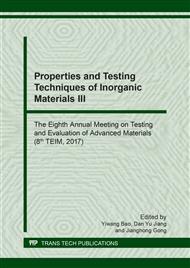[1]
S. Hou, C. Ke, Y. Li, B. Han. Preparation alloy and residue from titanium-bering blast furnace slag of metal othermic reduction, J. Ferrro-Alloys, 169 (2007) 20-33.
Google Scholar
[2]
Y. Hong, C. Ke, X. Liu, et al.Hydration performance of the Tailing slag from V-Ti-Si-Fe Alloy-making process based on Ti-bearing blast furnace slag, J. Iron steel vanadium titanium, 35 (2014) 41-46.
Google Scholar
[3]
B. Han, P. Wang, C. Ke, W. et al.Hydration behavior of spinel containing high alumina cement from high titania blast furnace slag, J. Cement and Concrete Research, 79 (2016) 257-264.
DOI: 10.1016/j.cemconres.2015.09.019
Google Scholar
[4]
P. Wang, B. Han, Y. Han, et al. Research on hydration capability of Panzhihua Iron and Steel CO.BF slag after extracting silicon-titanium alloy, J. Bulletin of the Chinese Ceramic Society, 27 (2008) 1208- 1211.
Google Scholar
[5]
N. Ukrainczyk, T. Matusinović. Thermal properties of hydrating calcium aluminate cement pastes , J. Cement and Concrete Research, 40 (2010) 128-136.
DOI: 10.1016/j.cemconres.2009.09.005
Google Scholar
[6]
V. Antonovič, J. Kerienė, R. Boris, M. Aleknevičius. The Effect of Temperature on the Formation of the Hydrated Calcium Aluminate Cement Structure, J. Procedia Engineering, 57 (2013) 99-106.
DOI: 10.1016/j.proeng.2013.04.015
Google Scholar
[7]
N.Y. Mostafa, Z.I. Zaki, Abd Elkader OH. Chemical activation of calcium aluminate cement composites cured at elevated temperature, J. Cement and Concrete Composites, 34 (2012) 1187-1193.
DOI: 10.1016/j.cemconcomp.2012.08.002
Google Scholar
[8]
L. Senff, D. Hotza, S. Lucas, V.M. Ferreira, J.A. Labrincha. Effect of nano-SiO2 and nano-TiO2 addition on the rheological behavior and the hardened properties of cement mortars, J. Materials Science and Engineering, 532 (2012) 354-361.
DOI: 10.1016/j.msea.2011.10.102
Google Scholar
[9]
S. Abd. El. Aleem, M. Heikal, W.M. Morsi. Hydration characteristic, thermal expansion and microstructure of cement containing nano-silica, J. Construction and Building Materials, 59 (2014) 151-160.
DOI: 10.1016/j.conbuildmat.2014.02.039
Google Scholar
[10]
M. Amin, K. Abu el-hassan. Effect of using different types of nano materials on mechanical properties of high strength concrete, J. Construction and Building Materials, 80 (2015) 116-124.
DOI: 10.1016/j.conbuildmat.2014.12.075
Google Scholar
[11]
M. Bastami, M. Baghbadrani, F. Aslani. Performance of nano-Silica modified high strength concrete at elevated temperatures, J. Construction and Building Materials, 68 (2014) 402-408.
DOI: 10.1016/j.conbuildmat.2014.06.026
Google Scholar
[12]
H. Li, H. Xiao, J. Yuan, et al. Microstructure of cement mortar with nano-particles , J. Composites,35 (2004) 185–189.
DOI: 10.1016/s1359-8368(03)00052-0
Google Scholar
[13]
Z. Rong, W. Sun, H. Xiao, G. Jiang. Effects of nano-SiO2 particles on the mechanical and microstructural properties of ultra-high performance cementitious composites, J. Cement and Concrete Composites, 56 (2015) 25-31.
DOI: 10.1016/j.cemconcomp.2014.11.001
Google Scholar
[14]
M. Rupasinghe, R. San Nicolas, P. Mendis, M. Sofi, T. Ngo. Investigation of strength and hydration characteristics in nano-silica incorporated cement paste, J. Cement and Concrete Composites, 80 (2017) 17-30.
DOI: 10.1016/j.cemconcomp.2017.02.011
Google Scholar
[15]
M. Stefanidou, I. Papayianni. Influence of nano-SiO2 on the Portland cement pastes, J. Composites Part B: Engineering, 43 (2012) 2706-2710.
DOI: 10.1016/j.compositesb.2011.12.015
Google Scholar
[16]
L.G. Li, Z.H. Huang, J. Zhu, A.K.H. Kwan, H.Y. Chen. Synergistic effects of micro-silica and nano-silica on strength and microstructure of mortar, J. Construction and Building Materials, 140 (2017) 229-238.
DOI: 10.1016/j.conbuildmat.2017.02.115
Google Scholar
[17]
A.M. Said, M.S. Zeidan, M.T. Bassuoni, Tian Y. Properties of concrete incorporating nano-silica, J. Construction and Building Materials, 36 (2012) 838-844.
DOI: 10.1016/j.conbuildmat.2012.06.044
Google Scholar
[18]
S. Shiri, M.H. Abbasi, A. Monshi, F. Karimzadeh. A study on mechanical and physical properties of monocalcium aluminate cement reinforced with nano-SiO2 particles, J. Composites Part B: Engineering, 56 (2014) 30-33.
DOI: 10.1016/j.compositesb.2013.08.057
Google Scholar
[19]
L.P. Singh, S.R. Karade, S.K. Bhattacharyya, M.M. Yousuf, S. Ahalawat. Beneficial role of nanosilica in cement based materials – A review, J. Construction and Building Materials, 47 (2013) 1069-1077.
DOI: 10.1016/j.conbuildmat.2013.05.052
Google Scholar
[20]
A. Nazari, S. Riahi. The effects of SiO2 nanoparticles on physical and mechanical properties of high strength compacting concrete, J. Composites Part B: Engineering, 42 (2011) 570-578.
DOI: 10.1016/j.compositesb.2010.09.025
Google Scholar


